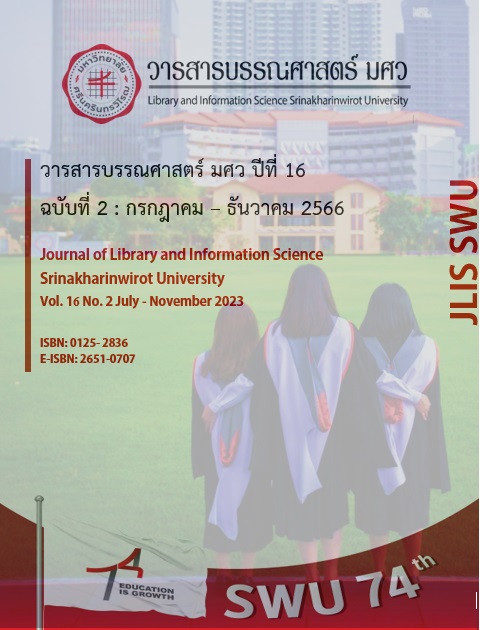ปัจจัยที่มีผลกระทบต่อพฤติกรรมการยอมรับเทคโนโลยีแพลตฟอร์ม Google Classroom ที่ใช้ในการเรียนการสอนออนไลน์: กรณีศึกษากระบวนวิชาสารสนเทศและเทคโนโลยีเพื่อการค้นคว้าและกระบวนวิชาการใช้ห้องสมุด
คำสำคัญ:
กูเกิลคลาสรูม, ความพยายามน้อยที่สุด, ยอมรับเทคโนโลยี,การรับรู้ว่าสะดวก, การรับรู้ว่าง่ายบทคัดย่อ
การวิจัยนี้มีวัตถุประสงค์เพื่อ 1) ศึกษาปัจจัยที่มีผลกระทบต่อพฤติกรรมยอมรับแพลตฟอร์ม Google Classroom สำหรับการเรียนการสอนออนไลน์ 2) ทดสอบปัจจัยความผันแปรร่วมที่สามารถอธิบายพฤติกรรมยอมรับแพลตฟอร์มGoogle Classroomสำหรับการเรียนการสอนออนไลน์ และ 3) เพื่อเสนอต้นแบบนำร่องพฤติกรรมยอมรับแพลตฟอร์ม Google Classroomสำหรับการเรียนการสอนออนไลน์ ขนาดกลุ่มตัวอย่างที่ใช้วิจัย 378 คนและสุ่มตัวอย่างแบบแบ่งชั้นภูมิ การเก็บรวบรวมข้อมูลโดยใช้แบบสอบถามออนไลน์ สถิติที่ใช้ในการวิเคราะห์ข้อมูลคือ ค่าความถี่ ค่าร้อยละ ค่าเฉลี่ย ส่วนเบี่ยงเบนมาตรฐาน และเทคนิคการวิเคราะห์การถดถอยพหุเพื่อการทดสอบสมมติฐานการวิจัย กำหนดระดับนัยสำคัญทางสถิติที่ระดับ .05
ผลการวิจัยพบว่า 1) การเรียนการสอนออนไลน์ด้วยแพลตฟอร์ม Google Classroom ของนักศึกษามหาวิทยาลัยรามคำแหงปรากฏว่าการรับรู้ว่ามีประโยชน์ และการรับรู้ว่าสะดวกนั้นมีความสำคัญมากว่าการรับรู้ว่าง่ายและความตั้งใจที่จะใช้ต่อพฤติกรรมยอมรับ Google Classroom 2) การทดสอบสมมติฐานแสดงให้เห็นว่าทั้งสี่ตัวแปรได้แก่ (1) การรับรู้ว่ามีประโยชน์ (2) การรับรู้ว่าสะดวก (3) การรับรู้ว่าง่าย และ (4) ความตั้งใจที่จะใช้ สามารถอธิบายความผันแปรร่วมทั้งหมดได้สูงถึง 70% ของพฤติกรรมยอมรับแพลตฟอร์ม Google Classroom สำหรับการเรียนการสอนออนไลน์ อย่างมีนัยสำคัญทางสถิติที่ระดับ.05 และ 3) ได้ตัวแบบนำร่องพฤติกรรมยอมรับแพลตฟอร์ม Google Classroom สำหรับการเรียนการสอนออนไลน์
References
Alassafi, M. O. (2022). E-learning intention material using TAM: A case study. Materials Today: Proceedings, 61, 873-877.
Alqahtani, A. (2019). Usability Testing of Google Cloud Applications: Students' Perspective. Journal of Technology and Science Education, 9(3), 326-339.
BBC News Thai. (2020). Covid-19 : Chronology of events, map, infographic, Total number of infections and deaths in Thailand and around the World. https://www.bbc.com/thai/thailand-52090088 (In Thai)
Davis, F.D. (1989). Perceived usefulness, perceived ease of use, and user acceptance of information technology. MIS Quarterly, 3, 319.
Er, E., Kopcha, T. J., Orey, M., & Dustman, W. (2015). Exploring college students’ online help-seeking behavior in a flipped classroom with a web-based help-seeking tool. Australasian Journal of Educational Technology, 31(5).
Fauzi, A., Wandira, R., Sepri, D., & Hafid, A. (2021). Exploring students' acceptance of Google Classroom during the covid-19 pandemic by using the technology acceptance model in West Sumatera Universities. Electronic Journal of e-Learning, 19(4), pp233-240.
Hidayah, N., & Fernanda, J. (2021). Analisis Penerimaan Aplikasi Pembelajaran Online Menggunakan Technology Acceptance Model 3 dan Partial Least Square Structural Equation Model (PLS-SEM). Journal Focus Action of Research Mathematic (Factor M), 3(2), 161–172. https://doi.org/10.30762/factor_m.v3i2.3097
Mooers, C. N. (1960). Mooers’ Law: Or, why some retrieval systems are used and others are not (Editorial). American Documentation, 11(3), ii, 204.
Huang, T.-H., Liu, F., Chen, L.-C., & Tsai, C.-C. (2021). The acceptance and impact of Google Classroom integrating into a clinical pathology course for nursing students: A technology acceptance model approach. PLoS ONE, 16(3), 1–16. https://doi.org/10.1371/journal.pone.0247819
Jansen, B. J., Spink, A., Bateman, J., & Saracevic, T. (1998, April). Real life information retrieval: A study of user queries on the web. In Acm sigir forum (Vol. 32, No. 1, pp. 5-17). New York, NY, USA: ACM.
Junan, R. D. (2021). The Effect of The Use Google Classroom on The Learning Effectiveness Students in FKIP Simalungun University in The Covid-19 Pandemic. Jurnal Scientia, 10(1), 22-26.
Kanuka, H. (2011). Interaction and the online distance classroom: Do instructional methods effect the quality of interaction. Journal of computing in higher education, 23(2), 143-156.
Liya, A. D. W. (2021). The effect of Google Classroom in Blended Learning on university students’ English ability. J-SHMIC: Journal of English for Academic, 8(1).
Mann, T. (1993). Library research model: A guide to classification, cataloging, and computer. New York: Oxford University Press.
Rukmana, G. W. (2021). Students’ Perception toward the Use of Google Classroom as Teaching and Learning English Media for EFL Students. Journal of Educational Study, 1(3), 191-199.
Santos, J. M. (2021). Google Classroom: Beyond the Traditional Setting. Problems of Education in the 21st Century, 79(4), 626-639.
Spector, P. E. (1992). Summated rating scale construction: An introduction. Newbury Park, CA: Sage.
Susanto, E., Sasongko, R. N., & Kristiawan, M. (2021). Constraints of online learning using Google Classroom during covid-19. Education Quarterly Reviews, 4(2).
Wijaya, A. (2016, February). Analysis of factors affecting the use of Google Classroom to support lectures. In The 5th International Conference on Information Technology and Engineering Application (ICIBA2016). Bina Darma University.
Yamane, T. (1970). Statistic: Introductory analysis (2nd ed.). New York: Harper & Row.
Zipf, G. K. (1949). Human behavior and the principle of least effort: An introduction to human ecology. New York: Hafner.
Additional Files
เผยแพร่แล้ว
ฉบับ
บท
License
Copyright (c) 2023 คณะมนุษยศาสตร์ มหาวิทยาลัยศรีนครินทรวิโรฒ

This work is licensed under a Creative Commons Attribution-NonCommercial-NoDerivatives 4.0 International License.
เกี่ยวกับลิขสิทธิ์
ลิขสิทธิ์ของบทความที่ปรากฏในวารสารบรรณศาสตร์ มศว เป็นของผู้นิพนธ์และคณะมนุษยศาสตร์ มหาวิทยาลัยศรีนครินทรวิโรฒ ทั้งนี้ บทความทุกเรื่องผ่านการตรวจสอบความถูกต้องทางวิชาการจากผู้ทรงคุณวุฒิ ข้อความและข้อมูลของบทความในวารสารฯ เป็นแนวคิดของผู้นิพนธ์ มิใช่เป็นความคิดเห็นของกองบรรณาธิการและมิใช่ความรับผิดชอบของคณะมนุษยศาสตร์ มหาวิทยาลัยศรีนครินทรวิโรฒ ไม่สงวนลิขสิทธิ์การนำไปใช้ประโยชน์ทางวิชาการ แต่ต้องอ้างอิงแสดงแหล่งที่มาและที่อยู่ในขอบเขตของกฎหมายลิขสิทธิ์


